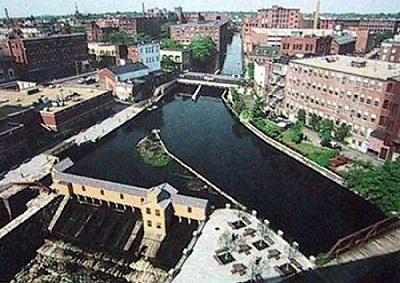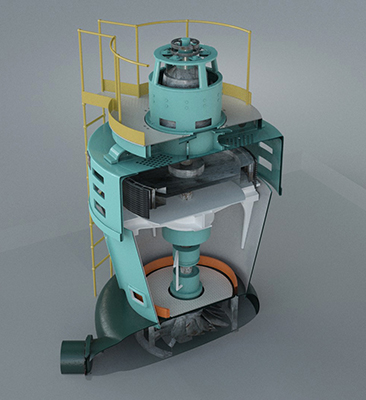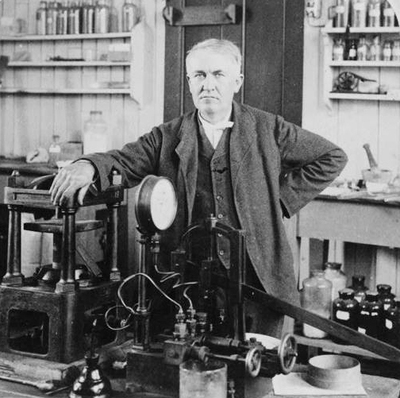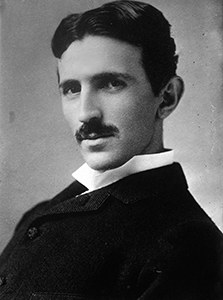Introduction
While towering dams like Hoover and Grand Coulee define the Bureau of Reclamation, it’s the water stored behind the dams that holds the power to transform lives. Most famously, Reclamation’s stored water made the desert bloom as irrigation works opened the American West to settlement. Less often told is how Reclamation’s water also brought electricity to the West, lighting up towns and homes, spurring industry, fueling the factories that helped to win World War II, and continuing today to provide a renewable and clean source of energy. That source is hydroelectric power, produced at Reclamation’s 53 hydroelectric powerplants, a number of them historic. Today, the Bureau of Reclamation provides more than 40 billion kilowatt hours a year, or enough electricity to serve 3.5 million homes. While Federal power is not generated for profit, it returns nearly a billion dollars in annual revenues to the U.S. Treasury.
The History

The use of falling water to power machines dates back at least two thousand years, when the Romans developed waterwheels to grind or “mill” grain into flour. By the eleventh century waterwheels were used widely in Europe. In early America, millwrights looked to streams, where a water fall of even 10 to 15 feet could power a mill. By the early 1800s, as the Industrial Revolution reached America, investors organized corporations to develop and control the productive force of water. In Massachusetts, manufacturers built an urban center of textile factories along the Merrimack River at Lowell, where the Pawtucket Falls plunged 32 feet over a series of drops and rapids in less than a mile. The Lowell mills, with their complex system of canals and gates, employed a new kind of waterwheel – the water turbine – which generated more efficient power to turn the gears, wheels, belts, and shafts that powered the looms where young women turned out millions of yards of cloth.
As the Lowell mill girls labored long hours for cash wages in the 1840s, electricity was a known force, but the idea that the power of falling water could generate electricity was still a thing of the future. It wasn’t until the 1880s that the nation’s first hydroelectric powerplants came into being, an advancement that followed the step-by-step progression of electrical technology.
Faraday’s Important Discovery

As early as 1752, Benjamin Franklin and his kite demonstrated the principles of electricity, and in 1800 the Italian scientist Alessandro Volta created a battery capable of holding an electrical charge. Batteries powered the earliest commercial use of electricity – the telegraph.
The key that unlocked the door to the generation of electricity was found in 1831 when the English physicist and chemist Michael Faraday discovered something quite amazing: Electricity could be created by using a magnet and copper wire. The principle – known as electromagnetic induction – harkens to Chemistry 101, where students learn that the basic building block of matter is the atom, with its positively-charged protons at the center and its negatively-charged electrons orbiting tightly around the core because the electrons are attracted to their opposite. The key to generating electricity centers on pulling the electrons out of their orbit. This is most easily accomplished when a material has loosely held electrons, a material such as the metal copper. Thus did Faraday use copper wire in his experiments. To pull the copper’s electrons out of their orbit, he needed a force – a force he found in the magnetic field of a magnet.
Faraday’s discovery laid the foundation for building the generators that create electricity: Take a coil of copper wire and spin it inside a magnet. Today, the energy necessary to turn the machinery that creates electricity can come from nuclear power, fossil fuels such as coal – or from the power of moving water. To generate hydroelectricity, water stored behind a dam is released through gates leading to huge pipes called penstocks, which drop from a high elevation to a lower one. The water gains pressure as it heads to the generators in the powerhouse. All generating units have four main parts: a turbine, a rotor (basically a series of magnets), a shaft connecting the turbine to the rotor, and a stator (basically a coil of copper wire). The force of the falling water spins blades in the turbine, which turn the shaft connected to the rotor, making it spin and creating a magnetic field as its magnets sweep past the coils of copper wire in the stator.
Electricity for Local Use

Michael Faraday’s discovery would prove crucial in the transformation of electricity from a curiosity into a powerful new technology. But in 1831 there was little need for a generator because the commercial technologies that relied on electricity – such as electric lights – had not yet appeared. It wasn’t until Thomas Edison perfected his incandescent light bulb in the late 1870s and opened his state-of-the-art Pearl Street Station in New York City in September 1882 that the commercial value of electricity was established. Edison’s was a complete electrical system that generated power at a central plant and carried it by copper wires right into scores of buildings in the surrounding district, where a light switch and electric fixtures replaced the dangerous, open flames of gas lamps, which hissed and smoked, consumed oxygen, and blackened the décor.
In time, thanks to electricity, Americans would discard their ice boxes for refrigerators and replace their coal or wood-burning stoves with electric ranges, furnaces, and hot water heaters. Electricity eased the routines of daily life and improved the American standard of living as it brought with it electric irons, washing machines, and toasters. Electricity also erased time and space when it powered the radio, which brought entertainment and the distant world to the door of ordinary Americans. Some intellectuals, however, saw a downside to electricity as the machines it powered displaced workers and led to what the scholar Henry Adams called “a larger process of historical acceleration” that he feared would create disastrous cultural change. But unlike Adams, the general public embraced electricity whole-heartedly as the evening suddenly was as bright as the day, a phenomenon showcased at new amusement parks and spectacularly illuminated world fairs. By 1910, 10 percent of American homes had electricity. That number soared to 70 percent by 1930, although “turning on the lights” was a nightly ritual that would not reach most American farms until after World War II.
As the wonders of electricity were only beginning to be understood in the 1880s, it was steam that powered the dynamos (generators using direct current) at Edison’s Pearl Street Station, though plans already were in the works to use the force of water to generate electricity. Just days after the Pearl Street Station went online, H. J. Rogers, a businessman in Appleton, Wisconsin, connected an Edison dynamo to a waterwheel on the Fox River. Rogers’ Vulcan Street Plant produced enough electricity to light his home and two nearby paper mills. By August 1886, 40 to 50 hydroelectric powerplants were online or under construction in the United States and Canada. They, like Rogers’ Vulcan Street Plant, took advantage of nearby water sources to generate electricity, though the electricity was only for local use. Finding a way to send electricity traveling across the miles to outlying areas and places without a ready water source was an obstacle that, once overcome, would lead to great expansion of the electric light and power industry.
Long-distance Transmission

Solving the difficulty of long-distance transmission led to “the battle of the currents” –Edison’s low-voltage direct current (DC) versus the high-voltage alternating current (AC) championed by the brilliant and eccentric Nikola Tesla and the manufacturing giant George Westinghouse. Direct current powered Edison’s incandescent bulb, but the current could travel only one-half mile from his Pearl Street Station. The potential of AC current soared with refinement of the transformer in 1885; now AC’s high voltage could be “stepped down,” which made it safe for local distribution, or “stepped up” to send it long distances over skinny wires. DC, on the other hand, could not be so easily converted from one voltage to another, making it more expensive and less efficient to transmit over longer distances.
It was Tesla who revolutionized the possibilities of AC when he perfected the AC motor by eliminating inefficient and awkward connections to create “an almost magical rotating magnetic field.” The key to Tesla’s motor was continuous current that kicked in, with almost no wearing parts. George Westinghouse, using a complete AC system developed by Tesla (motors combined with generators and transformers), won the AC-DC battle in 1896 when he harnessed the power of Niagara Falls to transmit electric power to Buffalo, New York – 26 miles distant.
By 1902, AC powerplants powered by Niagara Falls were producing one-fifth of all electricity generated in the United States. The Niagara power was transmitted to cities and industries in the East and upper Midwest. The ability to transmit electricity over long distances would prove especially important in the American West, where dams and hydroelectric plants often were located far from population centers.
Visit the National Park Service Travel Bureau of Reclamation's Historic Water Projects to learn more about dams and powerplants.
Last updated: January 13, 2017
